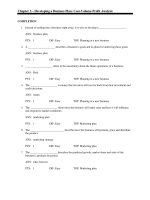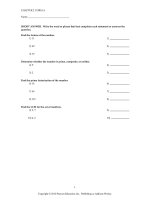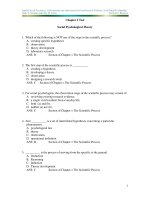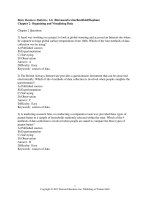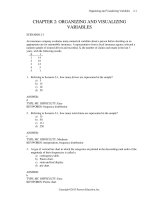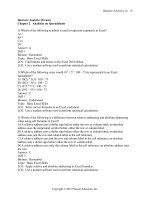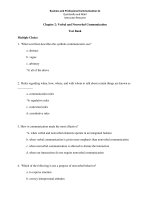Business statistics 2nd edition donnelly test bank
Bạn đang xem bản rút gọn của tài liệu. Xem và tải ngay bản đầy đủ của tài liệu tại đây (596.5 KB, 74 trang )
Business Statistics (Donnelly)
Chapter 2 Displaying Descriptive Statistics
1) A frequency distribution is a table that shows the number of data observations that
fall into specific intervals.
Answer: TRUE
Diff: 1
Keywords: frequency distribution
Objective: 2.2.1
2) Continuous data are values based on observations that can be counted and are typically
represented by whole numbers.
Answer: FALSE
Diff: 1
Keywords: discrete data
Objective: 2.2.1
3) Continuous data is often the result of measuring observations rather than counting
them.
Answer: TRUE
Diff: 1
Keywords: continuous data
Objective: 2.2.1
4) Discrete data can have an infinite number of values within a specific interval.
Answer: FALSE
Diff: 2
Keywords: discrete data
Objective: 2.2.1
5) The only limitation in the number of continuous values within an interval is the level of
precision of the measuring instrument.
Answer: TRUE
Diff: 1
Keywords: continuous data
Objective: 2.2.1
6) The sum of the relative frequencies for the relative frequency distribution should be equal to
or very close to 1.0 due to rounding.
Answer: TRUE
Diff: 1
Keywords: relative frequency distributions
Objective: 2.2.1
2-1
Copyright ©2015 Pearson Education, Inc.
2-2 Chapter 2
7) The sum of the cumulative relative frequencies for the cumulative relative frequency
distribution should be equal to or very close to 1.0 due to rounding.
Answer: FALSE
Diff: 2
Keywords: cumulative relative frequency distributions
Objective: 2.2.1
8) A symmetrical distribution is one in which the right side of the distribution looks like the
mirror image of the left side of the distribution.
Answer: TRUE
Diff: 1
Keywords: symmetrical distributions
Objective: 2.2.1
9) The goal of constructing a frequency distribution is to identify a useful pattern in the data and
often there is more than one acceptable way to accomplish this with grouped quantitative data.
Answer: TRUE
Diff: 1
Keywords: frequency distribution, grouped quantitative data
Objective: 2.2.1
10) When creating a frequency distribution with grouped qualitative data and 45 data points, five
classes should be set up using the 2k ≥ n rule.
Answer: FALSE
Diff: 1
Keywords: frequency distribution, grouped quantitative data
Objective: 2.2.1
11) When constructing a frequency distribution with grouped qualitative data, occasionally you
will end up with k + 1 or k — 1 classes to cover the entire data set.
Answer: TRUE
Diff: 1
Keywords: frequency distribution, grouped quantitative data
Objective: 2.2.1
12) Fifty employees at CSC Corporation responded to a survey asking for the number of minutes
they commute to work in the morning. Eighteen employees indicated that their commutes are 15
to less than 20 minutes. The relative frequency for this class in a frequency distribution would be
0.18.
Answer: FALSE
Diff: 1
Keywords: frequency distribution, grouped quantitative data
Objective: 2.2.1
Copyright ©2015 Pearson Education, Inc.
Displaying Descriptive Statistics 2-3
13) Fifty employees at CSC Corporation responded to a survey asking for the number of minutes
they commute to work in the morning. Management would like to know the proportion of
employees whose commute is less than 30 minutes. A cumulative relative frequency distribution
using grouped data would provide the information to answer this question.
Answer: TRUE
Diff: 1
Keywords: cumulative relative frequency distributions
Objective: 2.2.1
14) A fast food restaurant would like to examine the wait time for customers who use the drivethru window. The following class boundaries are appropriate to construct a frequency
distribution for this data.
Number of Minutes
0-2
2-4
4-6
6-8
Answer: FALSE
Diff: 2
Keywords: frequency distribution, grouped quantitative data
Objective: 2.2.1
15) Equal-size classes refer to classes for a frequency distribution using grouped quantitative
data that do not overlap.
Answer: FALSE
Diff: 1
Keywords: frequency distribution, grouped quantitative data
Objective: 2.2.1
16) Empty classes for a frequency distribution using grouped quantitative data result from class
widths that are too wide.
Answer: FALSE
Diff: 1
Keywords: frequency distribution, grouped quantitative data
Objective: 2.2.1
17) If the class sizes are not equal for a frequency distribution using grouped quantitative data,
patterns in the distribution could be misleading.
Answer: TRUE
Diff: 1
Keywords: frequency distribution, grouped quantitative data
Objective: 2.2.1
Copyright ©2015 Pearson Education, Inc.
2-4 Chapter 2
18) Under no circumstances should open-ended classes be used for a frequency distribution
using grouped quantitative data.
Answer: FALSE
Diff: 1
Keywords: frequency distribution, grouped quantitative data
Objective: 2.2.1
19) The estimated class width for a frequency distribution using grouped quantitative data should
be rounded to an integer value to make the class boundaries more readable.
Answer: TRUE
Diff: 1
Keywords: frequency distribution, grouped quantitative data
Objective: 2.2.1
20) Histograms displaying continuous data have gaps between their bars.
Answer: FALSE
Diff: 1
Keywords: histograms, continuous data
Objective: 2.2.2
21) Histograms displaying discrete data usually have gaps between their bars.
Answer: TRUE
Diff: 1
Keywords: histograms, continuous data
Objective: 2.2.2
22) Income and age are examples of data that are technically discrete but are normally displayed
in a continuous format.
Answer: TRUE
Diff: 1
Keywords: discrete data, continuous data
Objective: 2.2.2
23) The cumulative percentage polygon is a line graph that plots the cumulative relative
frequency distribution.
Answer: TRUE
Diff: 1
Keywords: cumulative percentage polygon
Objective: 2.2.2
24) Quantitative data are values that are categorical, describing a characteristic such as gender or
level of education.
Answer: FALSE
Diff: 1
Keywords: cumulative percentage polygon
Objective: 2.2.2
Copyright ©2015 Pearson Education, Inc.
Displaying Descriptive Statistics 2-5
25) A histogram is the appropriate type of graph to display both quantitative and qualitative data.
Answer: FALSE
Diff: 1
Keywords: qualitative data
Objective: 2.3.1
26) Bar charts can display data either horizontally or vertically.
Answer: TRUE
Diff: 1
Keywords: bar charts
Objective: 2.3.1
27) Clustered bar charts are preferred over stacked bar charts when you are comparing data
within categories, such as which team scored more points in 2009 when compared to 2010.
Answer: TRUE
Diff: 1
Keywords: clustered bar charts
Objective: 2.3.1
28) Clustered bar charts are preferred over stacked bar charts when you are displaying totals in
each category, such as what team scored the most points over the two-year period.
Answer: FALSE
Diff: 1
Keywords: stacked bar charts
Objective: 2.3.1
29) Pareto charts are a specific type of bar chart used in quality control programs by businesses
to graphically display the causes of problems.
Answer: TRUE
Diff: 1
Keywords: Pareto charts
Objective: 2.3.1
30) Pareto charts display the categories in an increasing order with the least problematic
categories shown first.
Answer: FALSE
Diff: 2
Keywords: Pareto charts
Objective: 2.3.1
31) Pie charts are an excellent tool for comparing proportions for qualitative (categorical) data.
Answer: TRUE
Diff: 1
Keywords: pie charts
Objective: 2.3.1
Copyright ©2015 Pearson Education, Inc.
2-6 Chapter 2
32) Each category of a pie chart occupies a segment of the pie that represents the cumulative
relative frequency of that category.
Answer: FALSE
Diff: 1
Keywords: pie charts
Objective: 2.3.1
33) When constructing a pie chart, all categories in the data set must be included in the pie.
Answer: TRUE
Diff: 1
Keywords: pie charts
Objective: 2.3.1
34) Choose a pie chart rather than a bar chart if you want to compare the relative sizes of the
classes to one another and together they comprise all possible categories.
Answer: TRUE
Diff: 1
Keywords: pie charts
Objective: 2.3.1
35) Choose a pie chart rather than a bar chart if you want to highlight the actual data values and
when the classes combined don't form a whole.
Answer: FALSE
Diff: 1
Keywords: pie charts
Objective: 2.3.1
36) Contingency tables help us identify relationships between two or more variables.
Answer: TRUE
Diff: 1
Keywords: contingency tables
Objective: 2.4.1
37) The stem and leaf display is a graphical technique that can used to display qualitative data.
Answer: FALSE
Diff: 1
Keywords: stem and leaf display
Objective: 2.5.1
38) A stem and leaf display allows you to observe individual data values while a histogram
groups data values together.
Answer: TRUE
Diff: 1
Keywords: stem and leaf display
Objective: 2.5.1
Copyright ©2015 Pearson Education, Inc.
Displaying Descriptive Statistics 2-7
39) The dependent variable on scatter plots is placed on the horizontal axis on the graph.
Answer: FALSE
Diff: 2
Keywords: scatter plot, independent variable
Objective: 2.6.1
40) The independent variable on scatter plots is placed on the vertical axis on the graph.
Answer: FALSE
Diff: 2
Keywords: scatter plot, independent variable
Objective: 2.6.1
41) The dependent variable in a scatter plot is influenced by changes in the independent variable.
Answer: TRUE
Diff: 2
Keywords: scatter plot, independent variable, dependent variable
Objective: 2.6.1
42) A data set is known as a times series when each data point is associated with a specific point
in time.
Answer: TRUE
Diff: 1
Keywords: time series
Objective: 2.6.1
43) When graphing a time series, the convention is to place the time data on the vertical axis of
the graph.
Answer: FALSE
Diff: 2
Keywords: time series
Objective: 2.6.1
44) A ________ is a table that shows the number of data observations that fall into
specific intervals.
A) histogram
B) frequency distribution
C) percent polygon
D) Pareto chart
Answer: B
Diff: 1
Keywords: frequency distribution
Objective: 2.2.1
Copyright ©2015 Pearson Education, Inc.
2-8 Chapter 2
45) ________ data are values based on observations that can be counted and are typically
represented by whole numbers.
A) Discrete
B) Continuous
C) Nominal
D) Time series
Answer: A
Diff: 1
Keywords: frequency distribution
Objective: 2.2.1
46) ________ are values that can take on any real numbers, including numbers that
contain decimal points. This data is often the result of measuring observations rather
than counting them.
A) Discrete
B) Cross-sectional
C) Ordinal
D) Continuous
Answer: D
Diff: 1
Keywords: continuous data
Objective: 2.2.1
47) A(n) ________ is a category in a frequency distribution.
A) polygon
B) ogive
C) class
D) histogram
Answer: C
Diff: 1
Keywords: class
Objective: 2.2.1
48) ________ display the proportion of observations of each class relative to the total
number of observations.
A) Frequency distributions
B) Cumulative relative frequency distributions
C) Relative frequency distributions
D) Histograms
Answer: C
Diff: 1
Keywords: relative frequency distributions
Objective: 2.2.1
Copyright ©2015 Pearson Education, Inc.
Displaying Descriptive Statistics 2-9
49) ________ totals the proportion of observations that are less than or equal to the
class at which you are looking.
A) Frequency distributions
B) Cumulative relative frequency distributions
C) Relative frequency distributions
D) Histograms
Answer: B
Diff: 1
Keywords: cumulative relative frequency distributions
Objective: 2.2.1
50) A ________ is a graph showing the number of observations in each class of a frequency
distribution.
A) frequency distribution
B) polygon
C) relative frequency distribution
D) histogram
Answer: D
Diff: 1
Keywords: histogram
Objective: 2.2.2
Copyright ©2015 Pearson Education, Inc.
2-10 Chapter 2
51) A statistics professor kept attendance records and recorded the number of absent students per
class. This data is displayed in the following histogram with the frequency of each number of
absent students shown above the bars.
How many total classes do these data represent?
A) 46
B) 100
C) 129
D) 150
Answer: C
Diff: 2
Keywords: histogram
Objective: 2.2.2
Copyright ©2015 Pearson Education, Inc.
Displaying Descriptive Statistics 2-11
52) A statistics professor kept attendance records and recorded the number of absent students per
class. This data is displayed in the following histogram with the frequency of each number of
absent students shown above the bars.
How many statistics classes had two or fewer students absent?
A) 9
B) 40
C) 42
D) 85
Answer: D
Diff: 2
Keywords: histogram
Objective: 2.2.2
53) The class ________ is the breadth, or range, of numbers we plan to put into each class of a
frequency distribution using grouped quantitative data.
A) boundary
B) frequency
C) width
D) number
Answer: C
Diff: 1
Keywords: class width, frequency distribution, grouped data
Objective: 2.2.1
Copyright ©2015 Pearson Education, Inc.
2-12 Chapter 2
54) The class ________ represent the minimum and maximum values for each class of a
frequency distribution using grouped quantitative data.
A) boundaries
B) frequencies
C) widths
D) numbers
Answer: A
Diff: 1
Keywords: class boundary, frequency distribution, grouped data
Objective: 2.2.1
55) Class ________ are the number of observations for each class of a frequency distribution
using grouped quantitative data.
A) boundaries
B) frequencies
C) widths
D) numbers
Answer: B
Diff: 1
Keywords: class frequency, frequency distribution, grouped data
Objective: 2.2.1
56) Which of the following is not a rule for constructing a frequency distribution using grouped
quantitative data?
A) Use equal-size classes.
B) Use mutually exclusive classes.
C) Avoid empty classes.
D) Avoid close-ended classes.
Answer: D
Diff: 1
Keywords: frequency distribution, grouped data
Objective: 2.2.1
Copyright ©2015 Pearson Education, Inc.
Displaying Descriptive Statistics 2-13
57) Consider the following frequency distribution.
Number of Minutes
0 to less than 5
5 to less than 10
8 to less than 13
13 to less than 18
Frequency
6
9
14
2
Which rule for constructing a frequency distribution using grouped quantitative data has been
violated?
A) Use equal-size classes.
B) Use mutually exclusive classes.
C) Avoid empty classes.
D) No rule has been violated.
Answer: B
Diff: 1
Keywords: frequency distribution, grouped data
Objective: 2.2.1
58) Consider the following frequency distribution.
Number of Minutes
0 to less than 5
5 to less than 10
10 to less than 15
15 to less than 20
Frequency
3
11
10
7
Which rule for constructing a frequency distribution using grouped quantitative data has been
violated?
A) Use equal-size classes.
B) Use mutually exclusive classes.
C) Avoid empty classes.
D) No rule has been violated.
Answer: D
Diff: 1
Keywords: frequency distribution, grouped data
Objective: 2.2.1
Copyright ©2015 Pearson Education, Inc.
2-14 Chapter 2
59) Consider the following frequency distribution.
Number of Customers
0-2
3-5
6-10
11-15
Frequency
10
7
12
5
Which rule for constructing a frequency distribution using grouped quantitative data has been
violated?
A) Use equal-size classes.
B) Use mutually exclusive classes.
C) Avoid empty classes.
D) No rule has been violated.
Answer: A
Diff: 1
Keywords: frequency distribution, grouped data
Objective: 2.2.1
60) A data set has 60 observations with a minimum value equal to 30 and a maximum value
equal to 72. The number of classes using the 2 k ≥ n rule is
A) 5.
B) 6.
C) 7.
D) 8.
Answer: B
Diff: 1
Keywords: frequency distribution, grouped data
Objective: 2.2.1
61) A data set has 60 observations with a minimum value equal to 30 and a maximum value
equal to 72. The estimated class width using the 2k ≥ n rule to determine the number of classes
is
A) 7.
B) 9.
C) 10.
D) 12.
Answer: A
Diff: 1
Keywords: frequency distribution, grouped data
Objective: 2.2.1
Copyright ©2015 Pearson Education, Inc.
Displaying Descriptive Statistics 2-15
62) ________ classes are classes with boundaries that do not overlap.
A) Equal-size
B) Open-ended
C) Mutually exclusive
D) Close-ended
Answer: C
Diff: 1
Keywords: frequency distribution, grouped data
Objective: 2.2.1
63) The following frequency distribution displays the daily sales of muffins at Avalon Bakery.
Number Sold
1-7
8-14
15-21
20-28
27-35
Frequency
5
8
13
21
3
What is the width of each class in this distribution?
A) 1
B) 7
C) 10
D) 35
Answer: B
Diff: 1
Keywords: frequency distribution, grouped data
Objective: 2.2.1
Copyright ©2015 Pearson Education, Inc.
2-16 Chapter 2
64) The following frequency distribution displays the daily sales of muffins at Avalon Bakery.
Number Sold
1-7
8-14
15-21
20-28
27-35
Frequency
5
8
13
21
3
How many days of data are included in this frequency distribution?
A) 25
B) 50
C) 75
D) 100
Answer: B
Diff: 1
Keywords: frequency distribution, grouped data
Objective: 2.2.1
65) The following frequency distribution displays the daily sales of muffins at Avalon Bakery.
Number Sold
1-7
8-14
15-21
20-28
27-35
Frequency
5
8
13
21
3
What is the probability that between 15 to 21 muffins will be sold tomorrow?
A) 0.26
B) 0.36
C) 0.44
D) 0.50
Answer: A
Diff: 1
Keywords: frequency distribution, grouped data
Objective: 2.2.1
Copyright ©2015 Pearson Education, Inc.
Displaying Descriptive Statistics 2-17
66) The following frequency distribution displays the daily sales of muffins at Avalon Bakery.
Number Sold
1-7
8-14
15-21
20-28
27-35
Frequency
5
8
13
21
3
What is the probability that 21 or fewer muffins will be sold tomorrow?
A) 0.52
B) 0.66
C) 0.80
D) 0.92
Answer: A
Diff: 1
Keywords: frequency distribution, grouped data
Objective: 2.2.1
67) The following frequency distribution displays the daily sales of muffins at Avalon Bakery.
Number Sold
1-7
8-14
15-21
20-28
27-35
Frequency
5
8
13
21
3
What is the probability that between 20 and 35 muffins will be sold tomorrow?
A) 0.14
B) 0.48
C) 0.58
D) 0.66
Answer: B
Diff: 1
Keywords: frequency distribution, grouped data
Objective: 2.2.1
Copyright ©2015 Pearson Education, Inc.
2-18 Chapter 2
68) The following distribution shows the frequency of daily revenue for an Italian restaurant in
Wilmington, Delaware.
Revenue
Under $2,000
$2,000 to under $4,000
$4,000 to under $6,000
$6,000 to under $8,000
$8,000 to under $10,000
Over $10,000
Frequency
18
10
26
14
8
4
What is the width of each class for this distribution?
A) $10,000
B) $8,000
C) $5,000
D) $2,000
Answer: D
Diff: 1
Keywords: frequency distribution, grouped data
Objective: 2.2.1
69) The following distribution shows the frequency of daily revenue for an Italian restaurant in
Wilmington, Delaware.
Revenue
Under $2,000
$2,000 to under $4,000
$4,000 to under $6,000
$6,000 to under $8,000
$8,000 to under $10,000
Over $10,000
Frequency
18
10
26
14
8
4
How many business days does this frequency distribution represent?
A) 100
B) 80
C) 32
D) 18
Answer: B
Diff: 1
Keywords: frequency distribution, grouped data
Objective: 2.2.1
Copyright ©2015 Pearson Education, Inc.
Displaying Descriptive Statistics 2-19
70) The following distribution shows the frequency of daily revenue for an Italian restaurant in
Wilmington, Delaware.
Revenue
Under $2,000
$2,000 to under $4,000
$4,000 to under $6,000
$6,000 to under $8,000
$8,000 to under $10,000
Over $10,000
Frequency
18
10
26
14
8
4
What is the probability that a randomly selected day will generate between $2,000 and under
$4,000 in revenue?
A) 0.100
B) 0.125
C) 0.325
D) 0.500
Answer: B
Diff: 1
Keywords: frequency distribution, grouped data
Objective: 2.2.1
71) The following distribution shows the frequency of daily revenue for an Italian restaurant in
Wilmington, Delaware.
Revenue
Under $2,000
$2,000 to under $4,000
$4,000 to under $6,000
$6,000 to under $8,000
$8,000 to under $10,000
Over $10,000
Frequency
18
10
26
14
8
4
What is the probability that a randomly selected day will generate under $2,000 in revenue?
A) 0.050
B) 0.160
C) 0.225
D) 0.500
Answer: C
Diff: 1
Keywords: frequency distribution, grouped data
Objective: 2.2.1
Copyright ©2015 Pearson Education, Inc.
2-20 Chapter 2
72) The following distribution shows the frequency of daily revenue for an Italian restaurant in
Wilmington, Delaware.
Revenue
Under $2,000
$2,000 to under $4,000
$4,000 to under $6,000
$6,000 to under $8,000
$8,000 to under $10,000
Over $10,000
Frequency
18
10
26
14
8
4
What is the probability that a randomly selected day will generate more than $6,000 in revenue?
A) 0.325
B) 0.650
C) 0.775
D) 0.900
Answer: A
Diff: 1
Keywords: frequency distribution, grouped data
Objective: 2.2.1
73) Bins in Excel represent the ______________.
A) lower boundary of each class in a frequency distribution
B) upper boundary of each class in a frequency distribution
C) width of each class in a frequency distribution
D) number of classes in a frequency distribution
Answer: B
Diff: 1
Keywords: frequency distribution, grouped data, bins
Objective: 2.2.2
74) When you want to compare the shape of two or more distributions on one graph, a ________
is your best choice
A) frequency distribution
B) histogram
C) percentage polygon
D) relative frequency distribution
Answer: C
Diff: 1
Keywords: percentage polygon
Objective: 2.2.2
Copyright ©2015 Pearson Education, Inc.
Displaying Descriptive Statistics 2-21
75) The ________ graphs the midpoint of each class as a line rather than a column.
A) bar chart
B) histogram
C) scatter plot
D) percentage polygon
Answer: D
Diff: 1
Keywords: percentage polygon
Objective: 2.2.2
76) The ________ is a line graph that plots the cumulative relative frequency distribution.
A) ogive
B) histogram
C) scatter plot
D) percentage polygon
Answer: A
Diff: 1
Keywords: ogive
Objective: 2.2.2
Copyright ©2015 Pearson Education, Inc.
2-22 Chapter 2
77) The following graph is a percent polygon showing the battery life, in hours, for a sample of
iPad 2s and iPad 3s. The diamond markers represent the iPad 2 battery life while the square
markers represent the iPad 3 battery life. Based on this graph, which of the following statements
is true?
A) The battery life of the iPad 3 tends to be longer than the battery life of the iPad 2.
B) The battery life of the iPad 3 tends to be about the same as the battery life of the iPad 2.
C) The battery life of the iPad 2 tends to be longer than the battery life of the iPad 3.
D) The difference in battery life between the iPad 2 and iPad 3 cannot be detected with this
graph.
Answer: C
Diff: 2
Keywords: percent polygon
Objective: 2.2.2
Copyright ©2015 Pearson Education, Inc.
Displaying Descriptive Statistics 2-23
78) The following graph is a cumulative percent polygon showing the battery life, in hours, for a
sample of iPad 2s and iPad 3s. The diamond markers represent the iPad 2 battery life while the
square markers represent the iPad 3 battery life. Based on this graph, which of the following
statements is true?
A) Approximately 20% of the iPad 2 batteries lasted more than 10 hours.
B) Approximately 20% of the iPad 2 batteries lasted less than 10 hours.
C) Approximately 60% of the iPad 3 batteries lasted more than 8 hours.
D) Approximately 80% of the iPad 3 batteries lasted less than 8 hours.
Answer: B
Diff: 2
Keywords: percent polygon
Objective: 2.2.2
Copyright ©2015 Pearson Education, Inc.
2-24 Chapter 2
79) The following chart shows the percentage of adults from various countries who admitted to
texting while driving in a recent survey.
This chart is an example of a _________ bar chart.
A) horizontal
B) stacked
C) clustered
D) vertical
Answer: D
Diff: 1
Keywords: vertical bar charts
Objective: 2.2.3
Copyright ©2015 Pearson Education, Inc.
Displaying Descriptive Statistics 2-25
80) The following chart shows the percentage of adults from various countries who admitted to
texting while driving in a recent survey.
Which of the following statements is not correct?
A) The USA has the highest percentage of adults who admitted to texting while driving.
B) The United Kingdom has a higher percentage of adults who admit to texting while driving
when compared to Germany.
C) Spain has the lowest percentage of adults who admitted to texting while driving.
D) The United Kingdom has a lower percentage of adults who admit to texting while driving
when compared to France.
Answer: B
Diff: 1
Keywords: vertical bar charts
Objective: 2.2.3
Copyright ©2015 Pearson Education, Inc.
